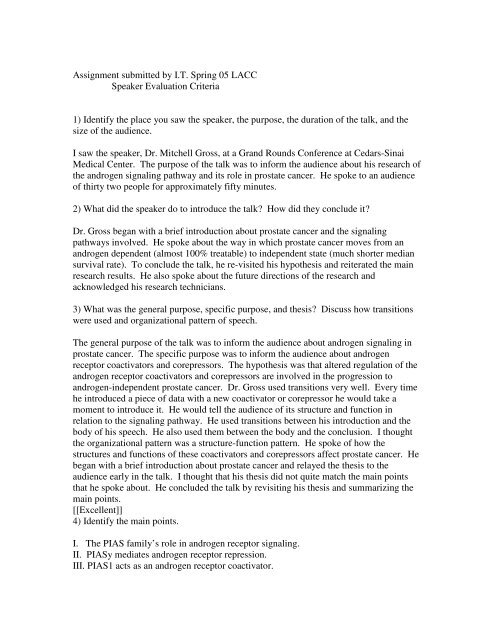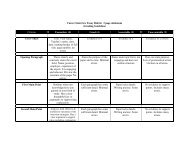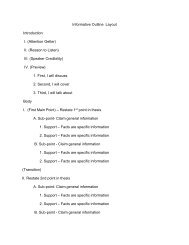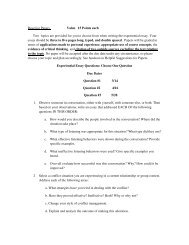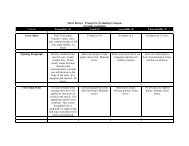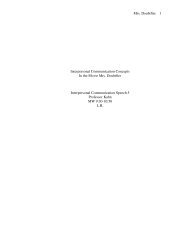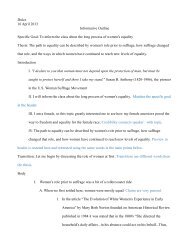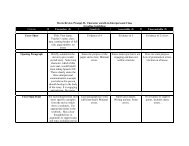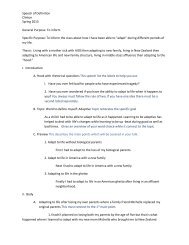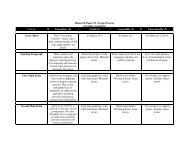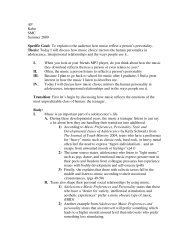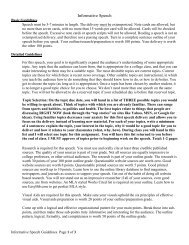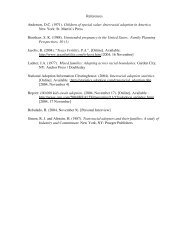Outside Speech Critique I.T. Spr. 05 LACC - Speechsuccess.net
Outside Speech Critique I.T. Spr. 05 LACC - Speechsuccess.net
Outside Speech Critique I.T. Spr. 05 LACC - Speechsuccess.net
You also want an ePaper? Increase the reach of your titles
YUMPU automatically turns print PDFs into web optimized ePapers that Google loves.
Assignment submitted by I.T. <strong>Spr</strong>ing <strong>05</strong> <strong>LACC</strong><br />
Speaker Evaluation Criteria<br />
1) Identify the place you saw the speaker, the purpose, the duration of the talk, and the<br />
size of the audience.<br />
I saw the speaker, Dr. Mitchell Gross, at a Grand Rounds Conference at Cedars-Sinai<br />
Medical Center. The purpose of the talk was to inform the audience about his research of<br />
the androgen signaling pathway and its role in prostate cancer. He spoke to an audience<br />
of thirty two people for approximately fifty minutes.<br />
2) What did the speaker do to introduce the talk? How did they conclude it?<br />
Dr. Gross began with a brief introduction about prostate cancer and the signaling<br />
pathways involved. He spoke about the way in which prostate cancer moves from an<br />
androgen dependent (almost 100% treatable) to independent state (much shorter median<br />
survival rate). To conclude the talk, he re-visited his hypothesis and reiterated the main<br />
research results. He also spoke about the future directions of the research and<br />
acknowledged his research technicians.<br />
3) What was the general purpose, specific purpose, and thesis? Discuss how transitions<br />
were used and organizational pattern of speech.<br />
The general purpose of the talk was to inform the audience about androgen signaling in<br />
prostate cancer. The specific purpose was to inform the audience about androgen<br />
receptor coactivators and corepressors. The hypothesis was that altered regulation of the<br />
androgen receptor coactivators and corepressors are involved in the progression to<br />
androgen-independent prostate cancer. Dr. Gross used transitions very well. Every time<br />
he introduced a piece of data with a new coactivator or corepressor he would take a<br />
moment to introduce it. He would tell the audience of its structure and function in<br />
relation to the signaling pathway. He used transitions between his introduction and the<br />
body of his speech. He also used them between the body and the conclusion. I thought<br />
the organizational pattern was a structure-function pattern. He spoke of how the<br />
structures and functions of these coactivators and corepressors affect prostate cancer. He<br />
began with a brief introduction about prostate cancer and relayed the thesis to the<br />
audience early in the talk. I thought that his thesis did not quite match the main points<br />
that he spoke about. He concluded the talk by revisiting his thesis and summarizing the<br />
main points.<br />
[[Excellent]]<br />
4) Identify the main points.<br />
I. The PIAS family’s role in androgen receptor signaling.<br />
II. PIASy mediates androgen receptor repression.<br />
III. PIAS1 acts as an androgen receptor coactivator.
5) Identify three types of support they used being as specific as possible.<br />
The types of supports that were used were mainly graphs, word charts and explanatory<br />
narratives. For example, with bar graphs, Dr. Gross showed how PIASy inhibits and<br />
PIAS1 activated androgen receptor signaling. With the word charts, Dr. Gross was able<br />
to identify the key points of the major propositions. Finally, he used explanatory<br />
narratives to explain how prostate cancer goes from an androgen dependent to<br />
independent disease.<br />
[[ Besides the above, did he cite any sources?]]<br />
6) Were there any visual aids used? What were they? How effective were they? What<br />
improvement would you suggest?<br />
The speaker used a PowerPoint presentation as a visual aid. This was very effective<br />
because the audience was able to easily visualize the data that the speaker was referring<br />
to during the presentation. For me personally, I process information more effectively<br />
when it is visually shown to me as opposed to simply spoken. PowerPoint allows the<br />
audience to refer to the screen if a specific point is not heard or needs clarification. I did<br />
find some areas upon which Dr. Gross could have improved on his visual aid. I thought<br />
that some of his slides were a little too wordy. He attempted to cram too much<br />
information on some of them. Also, the coloring on some of the slides could have been<br />
better. Some of the words and symbols were a little difficult to read because of their<br />
small size.<br />
[[Excelllent analysis]]<br />
7) Make a key word outline of the speech you heard.<br />
Introduction<br />
I. Androgen dependent prostate cancer.[[Are you missing a word here.]]<br />
II. Move to androgen independent cancer.<br />
III. Regulation of coactivators and corepressors responsible for move.<br />
Body<br />
I. PIAS family’s role<br />
A. PIAS isolation.<br />
B. PIAS family in androgen receptor signaling.<br />
II. PIASy represses androgen receptor.<br />
A. Dose dependent inhibition of androgen receptor.<br />
B. Interacts with the DNA binding domain.<br />
C. Uses LXXLL motif for inhibition.<br />
D. HDAC necessary for repression.
III. PIAS1 acts as coactivator of androgen receptor.<br />
A. PIAS1 expressed in many tissues.<br />
B. Activates androgen receptor signaling in a prostate cell line.<br />
C. Coactivators as targets.<br />
Conclusion<br />
I. Regulation of coactivators and corepressors responsible for dependent to independent<br />
prostate cancer shift.<br />
II. Future directions of coactivators and corepressors.<br />
8) Analyze the vocal qualities. Pay particular attention to the use of pitch, rate, pause,<br />
etc.<br />
I thought that Dr. Gross’ voice was very engaging. He spoke at the correct rate, neither<br />
too fast nor too slow. He never seemed rushed for time at any point during the talk. He<br />
used variation correctly when he wanted to call attention to certain important points. He<br />
seemed to be speaking with a varied pitch depending on the meaning that he wanted to<br />
portray. There was an obvious change in pitch depending on whether Dr. Gross was<br />
stating a fact or asking a question. Dr. Gross had mainly unfilled pauses that were<br />
extremely effective. For example, he would pause before an important idea, after asking<br />
a rhetorical question and at the end of an important assertion. He made very few filled<br />
pauses.[[Excellent]]<br />
9) How did the nonverbal language aid the speaker? How did it hurt the speaker?<br />
Dr. Gross’ had extremely effective nonverbal language. He had fantastic eye contact,<br />
communicating equally with members of the audience in all areas of the room. Dr.<br />
Gross’ facial expression portrayed his excitement and passion about the subject matter.<br />
He used hand gestures appropriately without fidgeting and stood up straight. I thought<br />
that Dr. Gross moved about the room a bit too much which was somewhat distracting for<br />
me. Overall, he had wonderful nonverbal language and spoke calmly and confidently to<br />
his audience.<br />
[[Very nice attention to detail.]]<br />
10) What concepts did you learn that you would apply to your own speaking skills?<br />
Dr. Gross is an extremely seasoned speaker from whom much can be learned. First of<br />
all, he was extremely knowledgeable and passionate about the subject matter that he was<br />
speaking about. He also spoke calmly and confidently to the audience. These skills are<br />
the ones that I would most like to perfect and apply.<br />
[[Excellent very well done.]]


